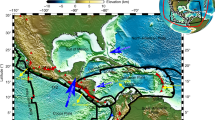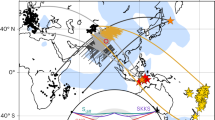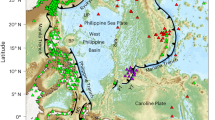Abstract
Seismic anisotropy is thought to result from the strain-induced lattice-preferred orientation of mantle minerals, especially olivine1,2, owing to shear waves propagating faster along the a-axis of olivine crystals than along the other axes. This anisotropy results in birefringence, or ‘shear-wave splitting’3, which has been investigated in numerous studies1,4. Although olivine is also anisotropic with respect to electrical conductivity5 (with the a-axis being most conductive), few studies of the electrical anisotropy of the upper mantle have been undertaken, and these have been limited to relatively shallow depths in the lithospheric upper mantle6,7. Theoretical models of mantle flow have been used to infer that, for progressive simple shear imparted by the motion of an overriding tectonic plate, the a-axes of olivine crystals should align themselves parallel to the direction of plate motion8,9. Here, however, we show that a significant discrepancy exists between the electromagnetic strike of the mantle below Australia and the direction of present-day absolute plate motion10. We infer from this discrepancy that the a-axes of olivine crystals are not aligned with the direction of the present-day plate motion of Australia, indicating resistance to deformation of the mantle by plate motion.
This is a preview of subscription content, access via your institution
Access options
Subscribe to this journal
Receive 51 print issues and online access
$199.00 per year
only $3.90 per issue
Buy this article
- Purchase on Springer Link
- Instant access to full article PDF
Prices may be subject to local taxes which are calculated during checkout




Similar content being viewed by others
References
Vinnik, L. P., Makeyeva, L. I., Milev, A., Usenko, A. Y. Global patterns of azimuthal anisotropy and deformations in the continental mantle. Geophys. J. Int. 111, 433–447 (1992).
Vinnik, L. P., Green, R. W. E. & Nicolaysen, L. O. Recent deformations of the deep continental root beneath southern Africa. Nature 375, 50–52 (1995).
Christensen, N. I. The magnitude, symmetry, and origin of upper mantle anisotropy based on fabric analyses of ultramafic tectonites. Geophys. J. R. Astron. Soc. 76, 89–112 (1984).
Silver, P. G. & Chan, W. W. Shear wave splitting and subcontinental mantle deformation. J. Geophys. Res. 96, 16429–16454 (1991).
Mackwell, S. J. & Kohlstedt, D. L. Diffusion of hydrogen in olivine: Implications for water in the mantle. J. Geophys. Res. 95, 5079–5088 (1990).
Kurtz, R. D., Craven, J. A., Niblett, E. R. & Stevens, R. The conductivity of the crust and mantle beneath the Kapuskasing Uplift: Electrical anisotropy in the upper mantle. Geophys. J. Int. 113, 483–498 (1993).
Mareschal, M. et al. Archaean cratonic roots, mantle shear zones and deep electrical anisotropy. Nature 375, 134–137 (1995).
McKenzie, D. Finite deformation during fluid flow. Geophys. J. R. Astron. Soc. 58, 689–715 (1979).
Ribe, N. M. Seismic anisotropy and mantle flow. J. Geophys. Res. 94, 4213–4223 (1989).
Gripp, A. E. & Gordon, R. G. Current plate velocities relative to the hotspots incorporating the NUVEL-1 global plate motion model. Geophys. Res. Lett. 17, 1109–1112 (1990).
Barruol, G., Silver, P. G. & Vauchez, A. Seismic anisotropy in the eastern United States: Deep structure of a complex continental plate. J. Geophys. Res. 102, 8329–8348 (1997).
Bahr, K. Interpretation of the magnetotelluric impedance tensor: regional induction and local telluric distortion. J. Geophys. 62, 119–127 (1988).
Groom, R. W. & Bailey, R. C. Decomposition of the magnetotelluric impedance tensor in the presence of local three-dimensional galvanic distortion. J. Geophys. Res. 94, 1913–1925 (1989).
Bahr, K. Geological noise in magnetotelluric data: a classification of distortion types. Phys. Earth Planet. Inter. 66, 24–38 (1991).
Schmucker, U. J. An introduction to induction anomalies. Geomagn. Geoelectr. 22, 9–33 (1970).
Bahr, K. & Filloux, J. H. Local Sq response functions from EMSLAB data. J. Geophys. Res. 94, 14195–14200 (1989).
Parkinson, W. D. Directions of rapid geomagnetic fluctuations. Geophys. J. R. Astron. Soc. 2, 1–14 (1959).
Bahr, K. & Duba, A. Is the asthenosphere electrically anisotropic? Earth Planet. Sci. Lett. 178, 87–95 (2000).
Simpson, F. A three-dimensional electromagnetic model of the southern Kenya Rift: departure from two-dimensionality as a consequence of a rotating stress field. J. Geophys. Res. 105, 19321–19334 (2000).
Debayle, E. SV-wave azimuthal anisotropy in the Australian upper mantle: preliminary results from automated Rayleigh waveform inversion. Geophys. J. Int. 137, 747–754 (1999).
Debayle, E. & Kennett, B. L. N. The Australian continental upper mantle: structure and deformation inferred from surface waves. J. Geophys. Res. 105, 25423–25450 (2000).
Acknowledgements
This research was supported by the Indian Institute of Geomagnetism, Bombay and the Geophysics Institute, University of Göttingen, via an initiative of Baldev Arora. I thank K. Bahr, A. Gatzemeier and P. Hahesy for help with fieldwork, G. Heinson for hospitality during my sojourn at the University of Adelaide and J. Booker for comments on an earlier version of this paper.
Author information
Authors and Affiliations
Corresponding author
Rights and permissions
About this article
Cite this article
Simpson, F. Resistance to mantle flow inferred from the electromagnetic strike of the Australian upper mantle. Nature 412, 632–635 (2001). https://doi.org/10.1038/35088051
Received:
Accepted:
Issue Date:
DOI: https://doi.org/10.1038/35088051
This article is cited by
-
Mantle flow and deep electrical anisotropy in a main gateway: MT study in Tierra del Fuego
Scientific Reports (2019)
-
On the Coupling of Geodynamic and Resistivity Models: A Progress Report and the Way Forward
Surveys in Geophysics (2016)
-
On Earth’s Mantle Constitution and Structure from Joint Analysis of Geophysical and Laboratory-Based Data: An Example
Surveys in Geophysics (2016)
-
Analytic solution to the magnetotelluric response over anisotropic medium and its discussion
Science China Earth Sciences (2013)
-
Grain size effect on the electrical conductivity of clinopyroxene
Contributions to Mineralogy and Petrology (2012)
Comments
By submitting a comment you agree to abide by our Terms and Community Guidelines. If you find something abusive or that does not comply with our terms or guidelines please flag it as inappropriate.



